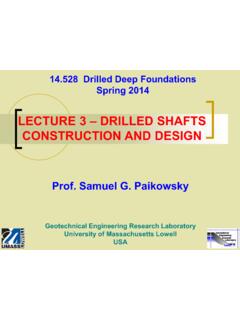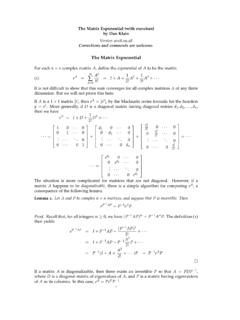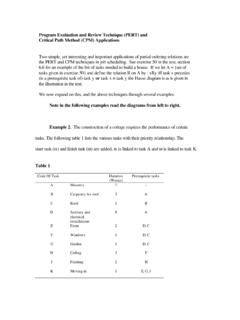Transcription of Lecture 1 – Introduction to Deep Foundations
1 1/24/2014. Drilled Deep Foundations Spring 2014. Lecture 1 Introduction to Deep Foundations Class Notes Samuel G. Paikowsky Geotechnical Engineering Research Laboratory University of Massachusetts Lowell 1. USA. OVERVIEW. Introduction Usage Historical Perspective Classification Design Process Economics 2. Drilled Deep Foundations Samuel Paikowsky 1. 1/24/2014. Introduction Definition PILE. (1) A structural member that is used to transmit surface loads to lower elevations in the soil. (2) Piles are common foundation tools for transferring superstructure through water and/or soft soil deposits.
2 The loads may be distributed through the soils (friction piles) or transferred to firm, underlying soil or rock strata (end bearing piles). Most piles function as a combination of the two. 3. Drilled Deep Foundations Samuel Paikowsky Introduction Definition The element of a structure that transfers loads to the underlying ground with performance consistent with the design of the structure. Loads are a combination of: Static Dynamic Horizontal Vertical 2. 1/24/2014. Introduction . Main Problem Limited ability to accurately assess the capacity and integrity state of a pile in the ground.
3 Required to allow safe and optimal design and construction History General Man's oldest method of overcoming the difficulties of founding above water and/or on soft soils. The Neolithic inhabitants of Switzerland supported their homes 12,000 years ago on driven wooden poles in shallow lakes. The ancient Egyptians depicted manpower pile driving operations and failures. The Romans supported many of their bridges over the Rhine river with driven timber piles. Modern analysis and literature began at the end of the 19th century. Diesel hammers were used after the second World War.
4 Drilled Deep Foundations Samuel Paikowsky Performance Some work better than others. 3. 1/24/2014. Performance Transcona Grain Elevator Bridge Abutment on Piles - 30 inches of Winnipeg, Manitoba Settlement over 10 years Photograph courtesy of FHWA-NHI-132012 Soils and October 18, 1913 Foundations Workshop Participants Workbook Tilt: 27 . Photograph and Figure from Baracos (1957). Performance Lee Roy Selmon Expressway, Tampa, FL. Drilled Shafts sink 11ft Repair Cost: $92,000,000. 155 of 224 Shafts Strengthened Source: Tampa Bay Times Photograph: St. Petersburg Times Photograph: St.
5 Petersburg Times Infographic: St. Petersburg Times 4. 1/24/2014. Boston Area Foundation Concepts Use of Deep Foundations (c) Lateral (a) Upper Strata Weak or Compressible (b) Uplift Loading End Bearing Friction Vesi (1977). 5. 1/24/2014. Use of Deep Foundations (d) Combined Uplift and Lateral (e) Scour (f) Liquefaction Loading Highway Signs Bridge Bent Or Noise Barriers Vesi (1977). Use of Deep Foundations (g) Fender Systems (h) Underpinning (i) Swelling Soils Vesi (1977). 6. 1/24/2014. Example Scour Bridge Abutment Scour Photograph courtesy of FHWA-NHI-132012 Soils and Foundations Workshop Participants Workbook Example Scour Scour at Bridge Abutment Photograph courtesy of FHWA-NHI-132012 Soils and Foundations Workshop Participants Workbook 7.
6 1/24/2014. HISTORICAL PERSPECTIVE OF. PILE DRIVING. Drilled Foundations are a relatively new technique. Pile driving, however, dates back many centuries. Herodotus, the fourth century BC Greek writer ( the father of history ), provides historical documented references to piles. Ancient Egyptians depicted hieroglyphics of pile driving. Romans, Chinese, Mesopotamians and others used driven piles. Egyptian Hieroglyphs of Pile Driving 8. 1/24/2014. HISTORICAL PERSPECTIVE OF PILE DRIVING. Hammer aka Pile Driver a mechanical device used to drive piles into soil Historical pile hammers includes a heavy weight placed between guides so that it is able to freely slide up and down vertically or inclined.
7 The hammer is placed upon a pile and the weight is raised -- an operation which may involve the use of manual labor, steam, air, diesel, or hydraulic power. The weight is then released and impacts the pile in order to drive it into the ground. HISTORICAL PERSPECTIVE OF PILE DRIVING. There is evidence that a pile driving device was used in the construction of Crannogs (artificial islands). at Oakbank and Loch Tay in Scotland as early as 5000. years ago. (Ref - History Trails: Ancient Crannogs from BBC's Mysterious Ancestors series ). Reconstructed Crann g on Loch Tay 9. 1/24/2014.
8 HISTORICAL PERSPECTIVE OF PILE DRIVING. Vitruvius was an architect and engineer under Julius Caesar in the first century and retired when Augustus died. Under Octavian's patronage, he wrote a ten-volume account of known technology by the name of De Re Architectura (On Architecutre). HISTORICAL PERSPECTIVE OF PILE DRIVING. But if a solid foundation is not found, and the site is loose earth right down, or marshy, then it is to be excavated and cleared and remade with piles of alder or of olive or charred oak, and the piles are to be driven close together by machinery, and the intervals between are to be filled with charcoal.
9 Then the Foundations are to be filled with very solid structures.. Ivo Herle, Institute of Geotechnical Engineering, TU Dresden, Germany, 2004. 10. 1/24/2014. HISTORICAL PERSPECTIVE OF PILE DRIVING. Double timber pilings were rammed into the bottom of the river by winching up a large stone and releasing it, thereby driving the piles into the riverbed. The most upstream and downstream pilings were inclined and secured by a beam, and multiple segments of these then linked up to form the basis of the bridge Roman Hammer (replica) used at the construction of Caesar's Rhine bridges during the Gallic War (1st bridge 55 BC and 2nd bridge 53 BC).
10 Roman Bridge on the Mosel- Currently in use in Trier Germany 11. 1/24/2014. Porta Nigra Trier Germany Manual Timber Pile Driving - Holland Movie Clip: Manual Timber Pile Driving - Holland Timber-a & Timber-b 12. 1/24/2014. HISTORICAL PERSPECTIVE OF PILE DRIVING. Pile Foundations of Bridges Bridge of Beaugency (central France). (earlier than 14th century). Foundations of a pier on sand masonry on short wooden piles Pebbles and clay (Herle, 2004). HISTORICAL PERSPECTIVE OF PILE DRIVING. Drop-Hammer Piling Rig, hand operated, designed by Francesco Di Giorgio (around 1450, credited as the first hammer design drawings).













